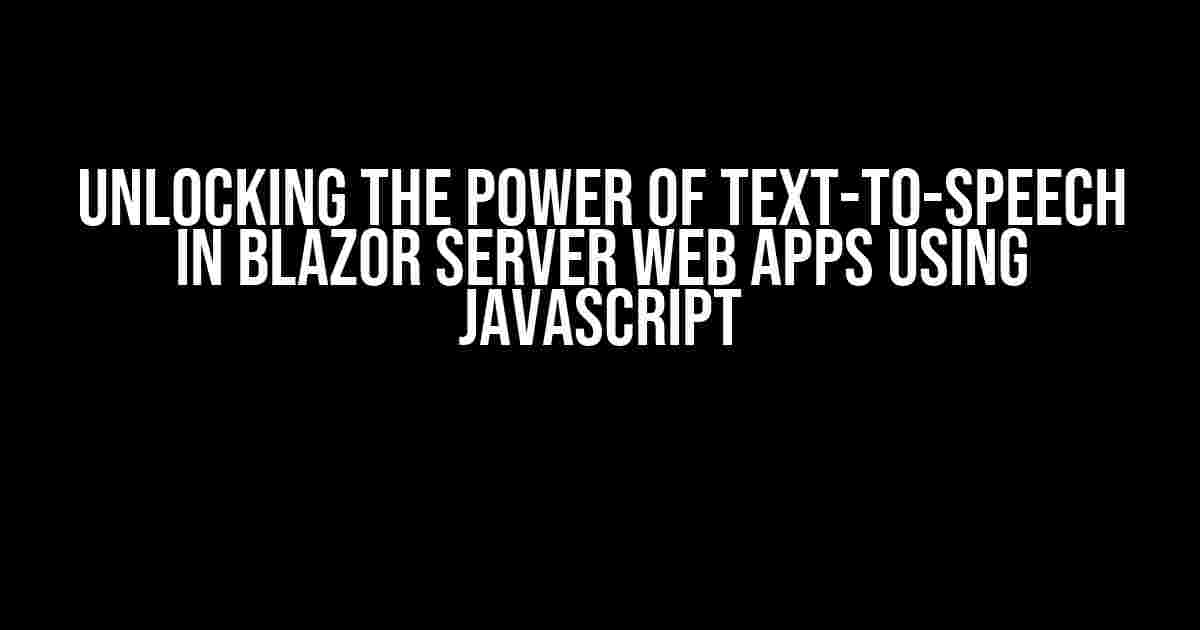Imagine being able to bring your Blazor Server web app to life with the power of text-to-speech functionality. With the help of JavaScript, you can do just that! In this comprehensive guide, we’ll walk you through the steps to integrate text-to-speech capabilities into your Blazor Server web app using JavaScript.
- What is Text-to-Speech?
- What is Blazor Server?
- What is JavaScript?
- Setting up the Project
- Adding Text-to-Speech Functionality using JavaScript
- Calling the JavaScript Function from Blazor
- Using the Text-to-Speech Functionality in Blazor
- Running the Application
- Enhancing the Text-to-Speech Functionality
- Conclusion
What is Text-to-Speech?
Text-to-speech (TTS) is a technology that converts written text into spoken audio. This technology has numerous applications, from virtual assistants like Siri and Alexa to language translation tools and accessibility features for visually impaired users. In the context of Blazor Server web apps, TTS can enhance the user experience by providing audio feedback, narrations, or even entire audio stories.
What is Blazor Server?
Blazor Server is a framework for building web applications using C# and .NET. It allows developers to create dynamic, interactive client-side experiences while maintaining the power and flexibility of server-side rendering. With Blazor Server, you can build fast, scalable, and secure web apps that can run on a variety of platforms.
What is JavaScript?
JavaScript is a programming language used for client-side scripting on the web. It’s commonly used for creating interactive web pages, web applications, and mobile applications. In the context of Blazor Server web apps, JavaScript can be used to extend the functionality of the app, interact with the browser, and even leverage the power of TTS.
Setting up the Project
To get started, create a new Blazor Server project in Visual Studio or your preferred IDE. Make sure to choose the “Blazor Server App” template and .NET 5 or later as the target framework.
dotnet new blazorserver -o MyTTSApp
Once the project is created, open the `MyTTSApp.csproj` file and add the following dependencies:
<ItemGroup>
<PackageReference Include="Microsoft.AspNetCore.Components.Web" Version="5.0.0" />
<PackageReference Include="Microsoft.AspNetCore.Components.WebAssembly" Version="5.0.0" />
<PackageReference Include="System.Text.Json" Version="5.0.0" />
</ItemGroup>
Adding Text-to-Speech Functionality using JavaScript
To add TTS functionality to our Blazor Server web app, we’ll use the `SpeechSynthesisUtterance` API provided by modern browsers. This API allows us to generate audio from text using the browser’s built-in TTS engine.
First, create a new JavaScript file called `tts.js` in the `wwwroot` folder of your project:
// tts.js
function speak(text) {
var utterance = new SpeechSynthesisUtterance(text);
speechSynthesis.speak(utterance);
}
This JavaScript function takes a text parameter and uses the `SpeechSynthesisUtterance` API to generate an audio utterance, which is then played back using the `speechSynthesis.speak()` method.
Calling the JavaScript Function from Blazor
To call the `speak()` function from our Blazor Server web app, we need to use the `JSRuntime` service provided by the framework. This service allows us to interact with JavaScript code from C#.
First, inject the `JSRuntime` service into your Blazor component:
@inject IJSRuntime JSRuntime
Next, create a C# method that calls the `speak()` function using the `JSRuntime` service:
async Task SpeakText(string text)
{
await JSRuntime.InvokeVoidAsync("speak", text);
}
This method takes a text parameter and calls the `speak()` function using the `JSRuntime.InvokeVoidAsync()` method.
Using the Text-to-Speech Functionality in Blazor
Now that we’ve set up the TTS functionality, let’s use it in a Blazor component. Create a new Razor component called `TtsComponent.razor`:
@page "/tts"
<h1>Text-to-Speech Demo</h1>
<input type="text" @bind="Text" />
<button @onclick="SpeakText">Speak</button>
@code {
private string Text { get; set; } = "Hello, world!";
async Task SpeakText()
{
await JSRuntime.InvokeVoidAsync("speak", Text);
}
}
This component includes a text input, a speak button, and a C# method that calls the `SpeakText()` method when the button is clicked.
Running the Application
To run the application, press F5 or select “Debug” > “Start Debugging” from the Visual Studio menu. This will start the Blazor Server web app in debug mode.
Open a web browser and navigate to `https://localhost:5001/tts`. You should see the TTS demo component with a text input and a speak button.
Type some text into the input field and click the speak button. If everything is set up correctly, you should hear the text being spoken by the browser’s TTS engine.
Enhancing the Text-to-Speech Functionality
Now that we’ve got the basic TTS functionality working, let’s enhance it with some additional features:
Rate and Pitch Control
We can control the rate and pitch of the TTS engine using the `SpeechSynthesisUtterance` API. Add the following code to the `speak()` function:
utterance.rate = 1.2; // Set the rate to 1.2x
utterance.pitch = 1.5; // Set the pitch to 1.5x
This will increase the rate and pitch of the TTS engine, making the audio sound faster and higher-pitched.
Language Support
We can also specify the language of the TTS engine using the `lang` property of the `SpeechSynthesisUtterance` API. Add the following code to the `speak()` function:
utterance.lang = 'es-US'; // Set the language to Spanish (US)
This will switch the TTS engine to Spanish (US) and pronounce the text accordingly.
Voices and Accents
Some browsers support multiple voices and accents for the TTS engine. We can specify the voice and accent using the `voice` property of the `SpeechSynthesisUtterance` API. Add the following code to the `speak()` function:
utterance.voice = speechSynthesis.getVoices().find(voice => voice.name === 'Google US English');
This will switch the TTS engine to the Google US English voice, which has a more natural and human-like tone.
Conclusion
In this article, we’ve explored the power of text-to-speech functionality in Blazor Server web apps using JavaScript. We’ve set up a basic TTS demo component that speaks text using the browser’s built-in TTS engine, and enhanced it with rate and pitch control, language support, and voice and accent selection.
With these features, you can create engaging and interactive web apps that provide an immersive experience for your users. Whether it’s a virtual assistant, a language translation tool, or an accessibility feature, TTS has the potential to revolutionize the way we interact with web applications.
So what are you waiting for? Get creative and start building your own TTS-powered Blazor Server web app today!
Frequently Asked Questions
Get ready to unleash the power of Text to Speech in your Blazor Server Web App using JavaScript!
What is the primary advantage of using Text to Speech in a Blazor Server Web App?
The primary advantage of using Text to Speech in a Blazor Server Web App is that it provides an immersive and engaging user experience, especially for visually impaired users. It also enhances the overall accessibility of the app.
How does JavaScript play a role in Text to Speech functionality in a Blazor Server Web App?
JavaScript is used to access the browser’s Web Speech API, which enables the Text to Speech functionality. JavaScript code is used to send text to the API, which then converts it into an audio file that can be played back to the user.
What is the best JavaScript library to use for Text to Speech in a Blazor Server Web App?
The best JavaScript library to use for Text to Speech in a Blazor Server Web App is ResponsiveVoice.js. It provides a simple and easy-to-use API, supports multiple languages, and is highly customizable.
How do I handle errors and exceptions in Text to Speech functionality using JavaScript in a Blazor Server Web App?
To handle errors and exceptions, you can use try-catch blocks in your JavaScript code to catch any exceptions that may occur during Text to Speech functionality. You can also use the `onspeecherror` event to handle any speech synthesis errors.
Are there any limitations to using Text to Speech functionality in a Blazor Server Web App using JavaScript?
Yes, there are some limitations to using Text to Speech functionality in a Blazor Server Web App using JavaScript. For example, the Web Speech API may not be supported in older browsers, and the quality of the speech synthesis may vary depending on the language and voice used.


